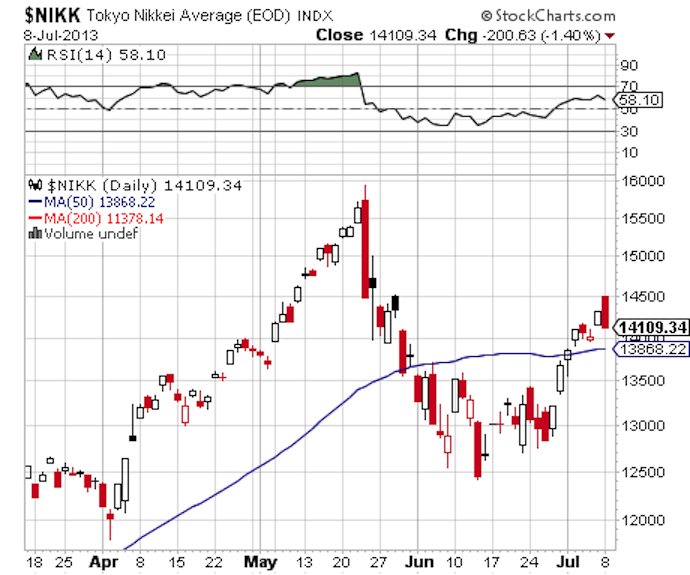The Japanese Equation: The Nikkei Bounces Back
After a string of precipitous declines in mid-May, the Japanese stock market has bounced back. The Nikkei 225 hit a multi-year high of 16020 on May 20th, and then proceeded to quickly head downwards, hitting around 12400 on June 6th before stabilizing. This represented an almost 22% correction. The equity index has since recovered a portion of its lost ground, and is currently trading around 14400. Japan is undertaking massive governmental intervention in order to jump start its economy after poor growth over the past decade. In order to fully understand Japan’s attempted economic recovery, it is not enough to look at only the Nikkei. Rather, the U.S. Dollar/Yen exchange rate is also of vital importance, as is the yield on Japanese bonds. The question becomes whether the Japanese economy is now on solid footing, or whether it may face further headwinds moving forward.
Japan is taking dramatic steps with stimulus funding in an attempt to reverse its long time deflationary economy. This effort has been spearheaded by recently elected Prime Minister Shinzo Abe, and has been nicknamed “Abenomics” by the financial media. Abe previously served as Prime Minister from 2006 to 2007, and was re-elected in October of 2012. Abenomics is taking a multi-pronged approach to dealing with Japanese macro-economic issues, including massive quantitative easing, a devaluation of the Japanese yen, and setting low interest rates. The Bank of Japan has stated that it intends to buy about 7 trillion yen monthly in bonds over the next two years. Abe has further pegged a 2% inflation rate to spur the economic growth.
Up until May, Abenomics looked like a stroke of genius. The yen had devalued to around 102 yen per dollar, the yield on Japanese bonds was low, and the Nikkei was skyrocketing. Then, it started falling apart in the middle of May. The yield on the 10 year Japanese bond rose from .315 percent in April to around 1 percent in May. The yen quickly strengthened versus the dollar, reaching 94.24 on June 17th. As mentioned previously, the Nikkei took a dive during the same period. However, the volatility has since declined. The Nikkei is rising again, the bond yields are low, and the yen has weakened to around 101 per USD. Some experts are declaring the increased volatility was only a slight correction on the path to a recovery for Japan.

While some observers are still bullish on Japan, others believe the recent bond volatility is a sign of things to come. Kyle Bass, the hedge fund manager of Hyman Capital Management, L.P., has been predicting an implosion of Japan’s economy for the past few years. Bass was one of the few managers to call the sub-prime mortgage crisis correctly, and profited by purchasing default credit swaps during that crisis. Bass has identified a number of macro-economic problems with Japan’s economy which he believes will not only hinder any attempted recovery, but eventually cause a meltdown. He says that Japan faces tremendous issues with its aging workforce. In addition, Bass believes that the Bank of Japan will not be able to keep bond yields down over the mid to long term. Rather, he has identified what he has termed the Rational Investor Paradox, where bond holders will have impetus to sell their bonds if they are facing negative real rates of return with an inflation target of 2%. Bass posits that while yields may stay low in the short term, this selling will ultimately overwhelm the Bank of Japan and long term interest rates will rise as a result.
For now, the situation in Japan is stable. However, it remains to be seen whether Abenomics can be successful in reversing deflation, and bring about a Japanese economic recovery. Abe is betting on an economic miracle his second time around as Prime Minister. American investors may gain exposure to Japan’s economy through the I-Shares MSCI Japan ETF (NYSE: EWJ) or the WisdomTree Japan Hedged Equity ETF (NYSE: DXJ).
Disclosure: The author is short EWJ.










































